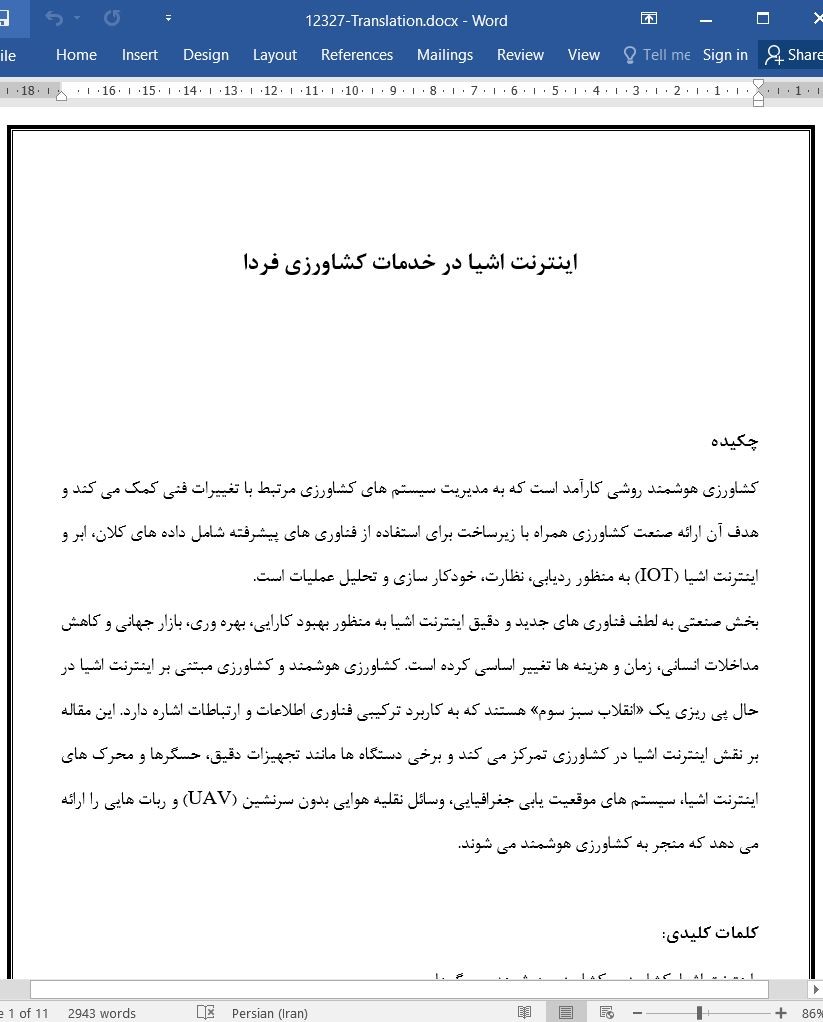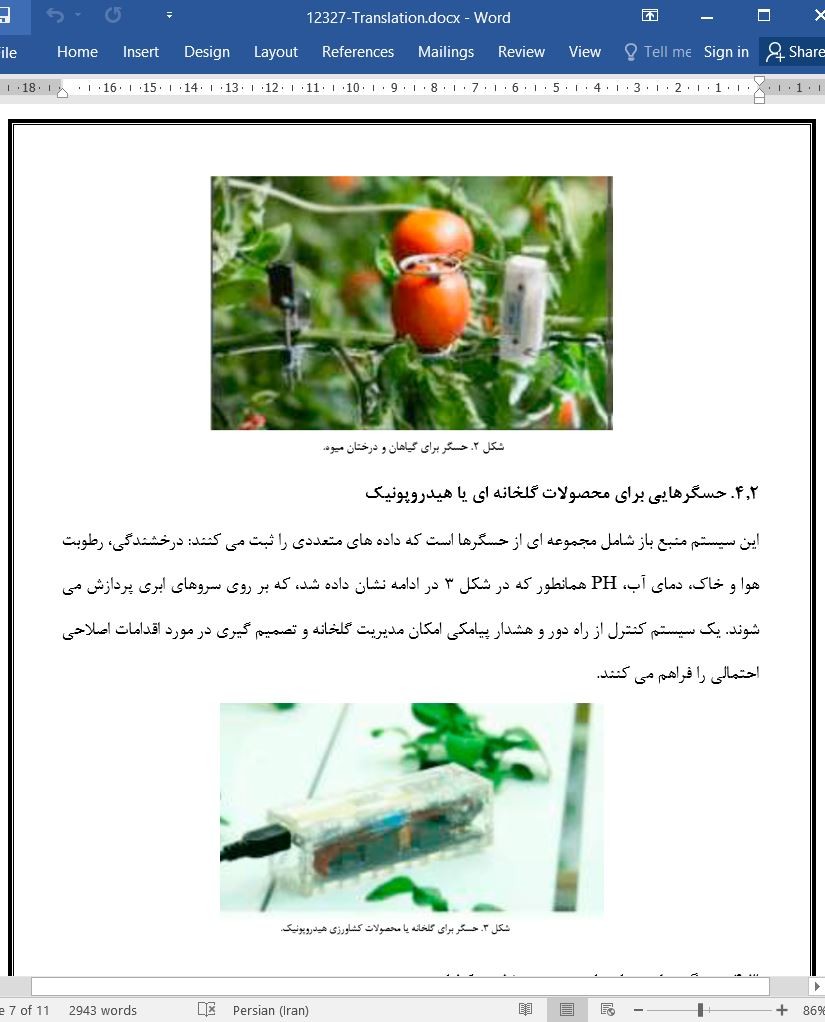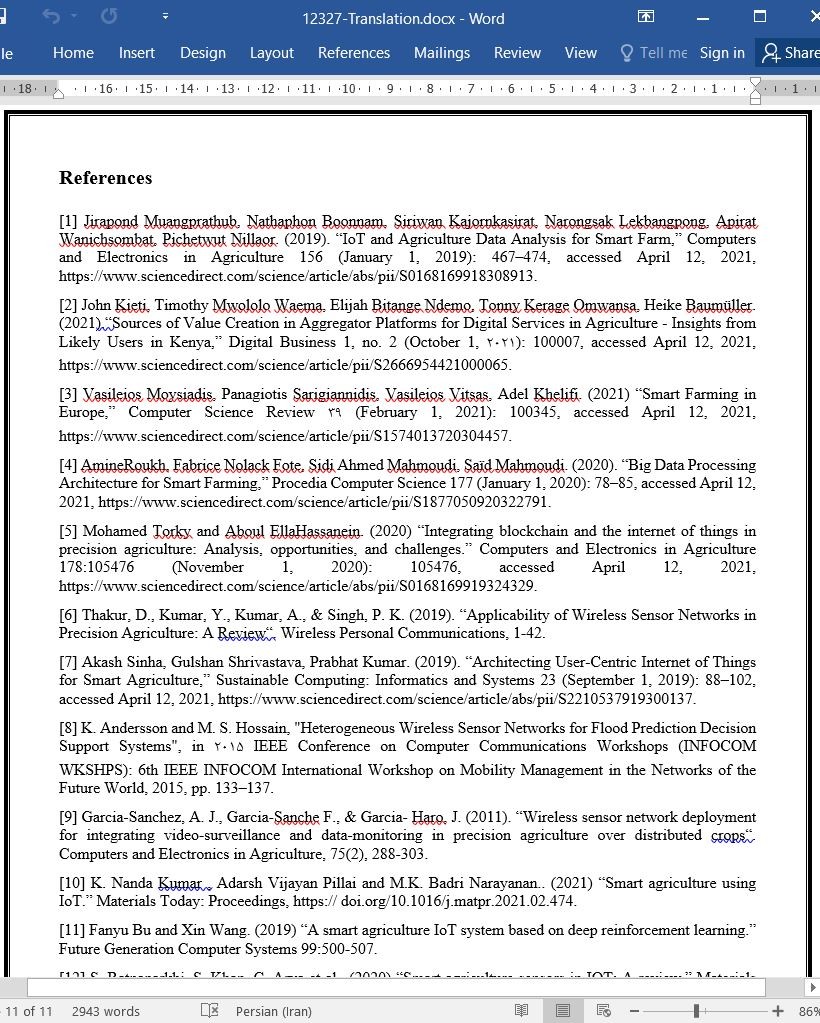
اینترنت اشیا در خدمات کشاورزی فردا
چکیده
کشاورزی هوشمند روشی کارآمد است که به مدیریت سیستم های کشاورزی مرتبط با تغییرات فنی کمک می کند و هدف آن ارائه صنعت کشاورزی همراه با زیرساخت برای استفاده از فناوری های پیشرفته شامل داده های کلان، ابر و اینترنت اشیا (IOT) به منظور ردیابی، نظارت، خودکار سازی و تحلیل عملیات است.
بخش صنعتی به لطف فناوری های جدید و دقیق اینترنت اشیا به منظور بهبود کارایی، بهره وری، بازار جهانی و کاهش مداخلات انسانی، زمان و هزینه ها تغییر اساسی کرده است. کشاورزی هوشمند و کشاورزی مبتنی بر اینترنت اشیا در حال پی ریزی یک «انقلاب سبز سوم» هستند که به کاربرد ترکیبی فناوری اطلاعات و ارتباطات اشاره دارد. این مقاله بر نقش اینترنت اشیا در کشاورزی تمرکز می کند و برخی دستگاه ها مانند تجهیزات دقیق، حسگرها و محرک های اینترنت اشیا، سیستم های موقعیت یابی جغرافیایی، وسائل نقلیه هوایی بدون سرنشین (UAV) و ربات هایی را ارائه می دهد که منجر به کشاورزی هوشمند می شوند.
1. مقدمه
در حال حاضر، تکامل فناوری امکان کشاورزی و فضاهای خانه سازی مناسب تر را فراهم می کند. فناوری اینترنت اشیا (IOT) با ساده سازی خود، تمام حوزه های زندگی معمولی را متحول کرده است. IOT به شبکه ای از اشیا اشاره می کند که یک شبکه خود پیکربندی را ایجاد می کنند. توسعه دستگاه های مبتنی بر کشاورزی هوشمند مانند IOT روز به روز با تقویت تولید محصولات کشاورزی، انقلابی در آن ایجاد می کند و همچنین باعث سودآوری و کاهش ضایعات می شود. هدف این مقاله کمک به کشاورزان برای بدست آوردن داده های واقعی (دما، رطوبت خاک، میزان نور از محیط خاک) برای نظارت موثر بر محیط زیست است که به دستیابی به کشاورزی هوشمند و افزایش عملکرد و کیفیت کلی محصولات کمک می کند.
Abstract
Smart agriculture is an approach that helps those managing agricultural systems deal with technological changes in an efficient manner, aiming to provide the agriculture industry with the infrastructure to leverage advanced technologies - including big data, the cloud and the Internet of Things (IoT) - to track, monitor, automate and analyze operations.
Thanks to new technologies and precisely the Internet of Things, the agricultural sector will have a radical change to improve efficiency, productivity, global market and reduce human intervention, time and costs. Smart agriculture and IoT-based agriculture are laying the foundation for a "third green revolution," which refers to the combined application of information and communication technologies. This paper focuses on role of IoT in agriculture and presents some devices such as precision equipment, IoT sensors and actuators, geo-positioning systems, unmanned aerial vehicles (UAVs) and robots that leads to smart agriculture.
1. Introduction
The evolution of technology now allows for more suitable agricultural and housing spaces. Internet of Things (IoT) technology has revolutionized all areas of common life by simplifying it. IoT refers to a network of objects that make a self-configuring network. The development of devices based on intelligent agriculture, IoT revolutionizes day by day the agricultural production strengthening it but also making it profitable and reducing waste. The purpose of this article is to help farmers to obtain real data (temperature, soil moisture, the amount of light from the soil environment) for effective monitoring of the environment, which will help to achieve smart farming and increase the overall yield and quality of products.
چکیده
1. مقدمه
2. برخی اصول فناوری برای کشاورزی
کشاورزی دقیق
کشاورزی دیجیتال
کشاورزی هوشمند
کلان داده
بلاک چین
هواپیماهای بدون سرنشین، ربات ها، نقشه های ماهواره ای
3. معماری زنجیره کشاورزی هوشمند مبتنی بر IOT
حسگرها
اتصال
ذخیره سازی
تصویرسازی و تحلیل کسب و کار
4. حسگرهایی با کارآمدی بیشتر و بیشتر با هزینه کمتر
4.1. حسگر برای گیاهان و درختان میوه
4.2. حسگرهایی برای محصولات گلخانه ای یا هیدروپونیک
4.3. حسگر برای هواپیمای بدون سرنشین کشاورزی
4.4. قلاده های متصل
5. افزایش ارزش داده ها برای تبدیل آن به اطلاعات هوشمند و مفید
6. نتیجه گیری
منابع
Abstract
1. Introduction
2. Some technology principles for smart agriculture
Precision agriculture
Digital agriculture
Smart farming
Big Data
Blockchain
Drones, robots, satellite maps
3. IoT-based smart agricultural chain architecture
Sensors
Connectivity
Storage
Visualization and business analysis
4. More and more efficient sensors at lower cost
4.1. Sensor for plants and fruit trees
4.2. Sensors for greenhouse or hydroponic crops
4.3. Sensor for agricultural drone
4.4. Connected collars
5. Enhance the value of data to make it intelligent and useful information
6. Conclusion
References
- اصل مقاله انگلیسی با فرمت ورد (word) با قابلیت ویرایش
- ترجمه فارسی مقاله با فرمت ورد (word) با قابلیت ویرایش، بدون آرم سایت ای ترجمه
- ترجمه فارسی مقاله با فرمت pdf، بدون آرم سایت ای ترجمه



